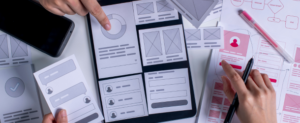Success in the GovCon industry is all about providing high quality, innovative services in order to help build better government.
At RIVA, we want our customers to elevate their expectations and expect more from their contractors. Why? Because raising expectations drives us to do more, think outside the box, and push ourselves to perform at a higher level. We’re not okay with being just your average government contractor. Your mission is our mission, together we can reach the stars.
Many companies who claim to provide Customer Experience (CX) are relying on artifacts developed through a series of touchpoint meetings. The baseline for any CX project is the creation of personas, customer journey maps, and UX/UI design. If your contractor thinks the work is done after these documents are created, you’re going to be sorely disappointed with the end results. Don’t get me wrong, creating these artifacts is important, but if they’re developed the wrong way, they are essentially useless. At RIVA, we go beyond merely designing a few artifacts; we bring CX to life.
You might be saying to yourself, “That sounds like the way my office approaches CX! What are we doing wrong? How can we improve?” Push beyond just thinking about customer experience to thinking about how your entire business functions. For example, if you oversee patent adjudications, think beyond the adjudication process and put yourself in the shoes of an everyday customer who is applying for a patent. What does their entire end-to-end experience look and feel like? How can technology advancements, process improvements, and design of the journey and interaction points improve that individual’s experience? We are not talking about where a widget needs to go on the landing page of a website, but how can things like AI and VR/AVR radically change and improve a customer experience exponentially?
We want you to reimagine how your entire business delivers CX.
How RIVA approaches CX
RIVA facilitates a series of workshops using team exercises and voting to achieve collaborative outcomes for services that support people from across the globe. Through workshops and interviews, we gain insights that inform our strategic direction. We use web interfaces and process flows to learn how each user interacts to create a seamless experience.
We review and score the customer’s vision and mission statements to confirm they represent the desired concepts and set the tone for the future of the organization. Updates are created based on a series of visioning exercises to depict the ideal state from all stakeholders. We innovate and evolve the underlying platform using new, innovative technologies like RPA, AI, and VR/AVR. This creates multiple strategic avenues for how CX and platform architectures can co-evolve as a service design over the next three to five years.
Given our fast-paced virtual world, collaboration practices and tools have adapted to support large, geographically dispersed teams. Tools and approaches designed to foster simple and frequent communication for large teams will have lasting benefits and enable successful collaboration across the organization.
We use key performance metrics to check progress against project roadmaps and regularly seek feedback which helps us reflect on successes and challenges which might enable course corrections. Visible metrics are important because they help highlight the benefits of modernization which in turn helps gain buy-in and user adoption.
Establishing Metrics for Success
RIVA surveys our customers and the vendor community, and we leverage past survey results to determine what works and what doesn’t work. We work with our customers to identify the right stakeholder groups to engage across the enterprise. We gather stakeholder feedback through a combination of online surveys, interview sessions, workshops, and technology reviews. Then, we evaluate the service offerings, quality and efficiency of customer service, communications, responsiveness, and business value provided. We use Likert-scale questions following OMB regulations to assess our customer experience. Overall, we evaluate a range of areas to best inform our approach and strategy.
Our approach is aligned with System Thinking and benefits our customers by fostering deeper empathy for user needs, challenges, and priorities. We use Human Centered Design (HCD) as a problem-solving framework, because it allows us to be more responsive to stakeholder needs. Using HCD helps us understand an organization’s dynamic needs and which serves as a catalyst for innovation and modernization.
We create a summary list that identifies the approach, methodology, technology, or product, and potential use cases to address administrative, business, and scientific gaps. Our main objective is to assess the current state, then improve by using lessons learned from prior challenges. We do this while simultaneously identifying ongoing business needs and prioritizing each need by risk level.
Continuous improvement is woven throughout the project in alignment with Agile principles. This provides a flexible approach to strategy realization and fostering change based on organizational needs. Simply put, the change process can be executed whenever an improvement is needed.
We’re Here for You
Implementing new ways of thinking and working are critical for sustained business– it all centers on the experience you deliver to your customers and employees. What CX challenges are you seeing at your organization?





